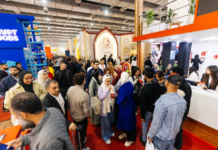
At the maiden IntraPac India 2024 show in Greater Noida, a collaborative conference of the Authentication Solution Providers Association (ASPA) and the Indian Printing Packaging & Allied Machinery Manufacturing Association (IPAMA) put the spotlight on combating counterfeiting through innovative solutions, authentication, traceability, and secure sustainable packaging.
Industry stakeholders such as Manoj Kochar, president of ASPA, Ajai Srivastava, former director of the Security Printing & Minting Corporation of India (SPMCIL), Honey Bharadwaj, deputy general manager of Dhanuka Agritech, and Pratibha Malakar, AVP at Chemanaylst offered their perspectives and insights on counterfeiting and solutions.
Kochar highlighted various facets of combating counterfeiting and the implication of authentication – emphasizing the importance of the phygital approach. With a fusion of physical and digital elements, the phygital approach can be a solution to the escalating challenges posed by counterfeiting. He explained how this integrated strategy that combines tangible features with digital technologies enhances product security and authenticity.
“The phygital approach could prove to be a potent weapon against counterfeiting. Embracing a phygital approach offers multifaceted protection, ensuring that products remain safeguarded against illicit replication. The effective role of secure sustainable packaging with covert and overt features must be the focus. Creating awareness among stakeholders is a much-needed requirement in strengthening the brand integrity,” Kochar said.
According to Srivastava, there is a need for awareness-inducing programs such as ‘Jago Grahak Jago’ to make consumers more vigilant and remain aware of the threat of counterfeit products. He underscored the importance of public awareness in combating counterfeiting, drawing parallels to the zero-tolerance policy for counterfeit currency. He spoke about how the Security Printing & Minting Corporation of India (SPMCIL) and the Bharatiya Reserve Bank Note Mudran (BRBNMPL) employ complete traceability, right from the production floor to the release of the banknotes into the system after a 100% inspection system.
“Platforms such as YouTube or other social media could further strengthen consumers. However, brand owners need to actively impart information on how consumers can be more cautious against fake products. Additionally, with the implementation of IoT (internet of things) and Industry 4.0, traceability in the supply chain could be enhanced,” Srivastava said.
The discussion underscored the significance of incorporating advanced technologies such as nano-engraving, RFID, holograms, QR codes, and blockchain into packaging design. These technologies not only enable real-time tracking and authentication but also empower consumers to verify product authenticity effortlessly.
On the importance of anti-counterfeiting solutions, Bharadwaj said, “The problem arises somewhere in the middle of the supply chain. The freight operators, at times, collude with the counterfeiters for better profit margins. Upgrading technologies is the only means to stay ahead of the counterfeiters. But if the end consumer doesn’t take authentication seriously, all efforts are wasted.”
Kochar’s advocacy for the phygital approach resonated strongly with attendees, reaffirming its status as a transformative solution in the fight against counterfeit products. The discussions also veered around developing a strategy to incentivize scanning QR codes for the consumer. “If the consumer feels there’s any merit to scanning a QR code, it can better impact consumer behavior in general,” he adds.
IndiFoodBev — authentic, impactful and influential
An English-language food and beverage processing and packaging industry B2B platform in print and web, IndiFoodBev is in its third year of publication. It is said that the Indian food and beverage industries represent approximately US$ 900 billion in revenues which implies more than 20% of the country’s GDP. Eliminating the wastage on the farmside can help to deliver more protein to a higher number of the population apart from generating sizable exports. The savings in soil, seeds, water, fertilizer, energy and ultimately food and nutrition could be the most immense contribution that country is poised to make to the moderation of climate change.
To improve your marketing and grow sales to the food and beverage processing and packaging industry, talk to us. Our research and consulting company IppStar [www.ippstar.org] can assess your potential and addressable markets in light of the competition. We can discuss marketing, communication, and sales strategies for market entry and growth.
Suppliers and service providers with a strategy and budget for targeted marketing can discuss using our hybrid print, web, video, and social media channels to create brand recognition linked to market relevance. Our technical writers are ready to meet you and your customers for content.
The second largest producer of fruit and vegetables in the world is continuously expanding processing capacities and delivery systems with appropriate innovative technologies. We cover product and consumer trends, nutrition, processing, research, equipment and packaging from farm to thali. Get our 2025 media kit and recalibrate your role in this dynamic market. Enhance your visibility and relevance to existing markets and turn potential customers into conversations. Ask for a sample copy of our bi-monthly in print or our weekly IndiFoodBev eZine each Wednesday.
For editorial info@ippgroup.in — for advertisement ads1@ippgroup.in and for subscriptions subscription@ippgroup.in
Naresh Khanna – 10 February 2025
Subscribe Now










